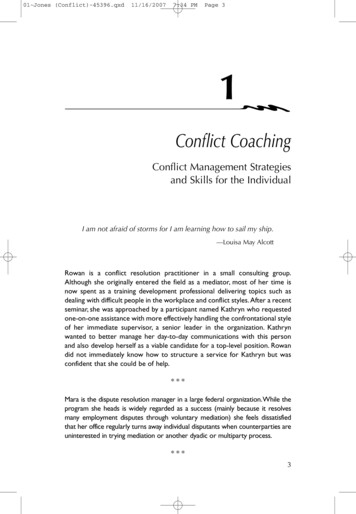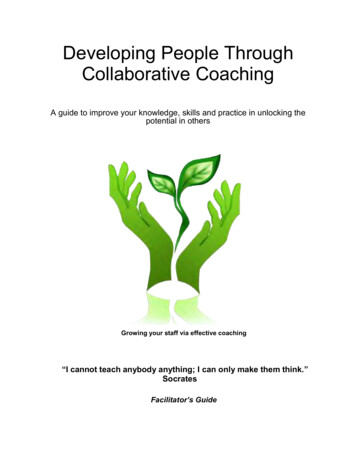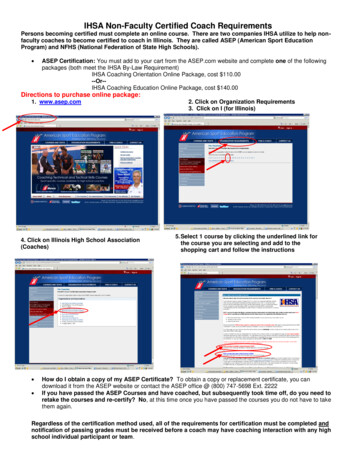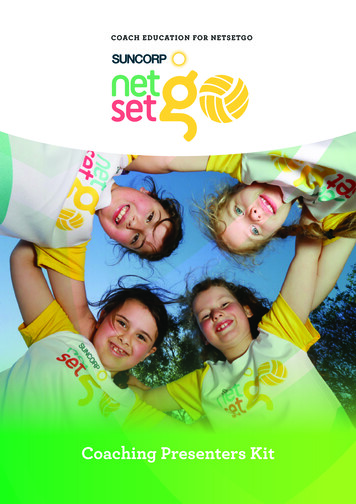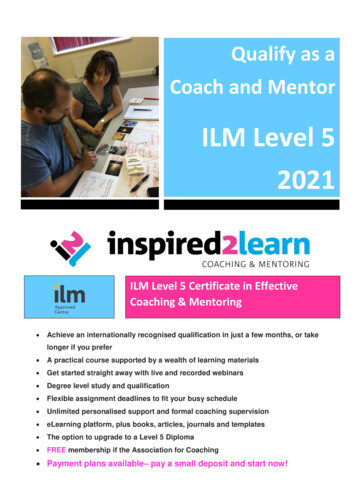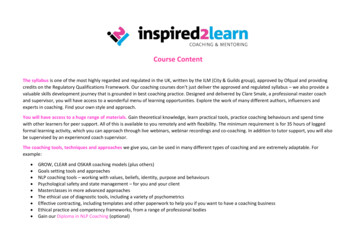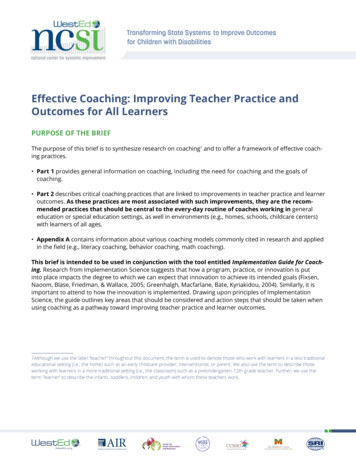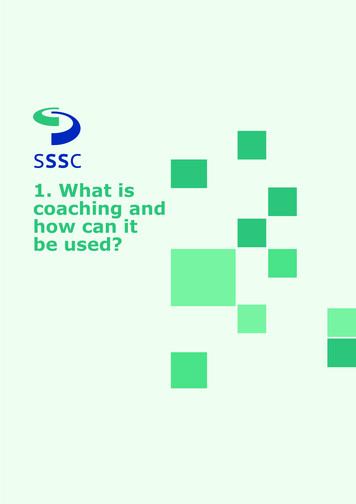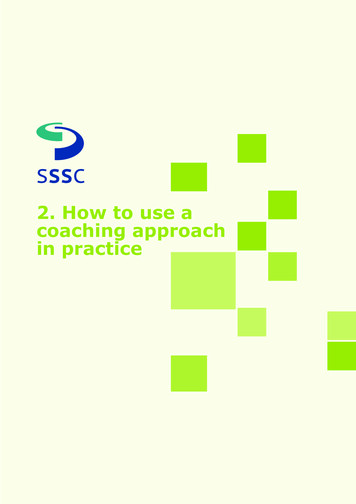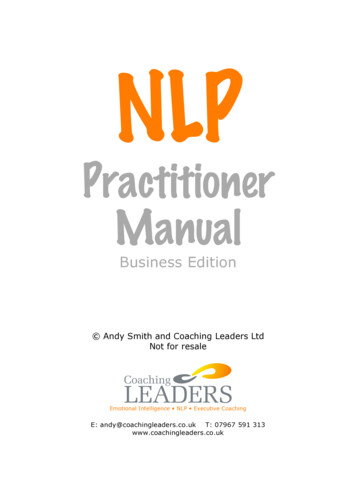
Transcription
NLPPractitionerManualBusiness Edition Andy Smith and Coaching Leaders LtdNot for resaleEmotional Intelligence NLP Executive CoachingE: andy@coachingleaders.co.uk T: 07967 591 313www.coachingleaders.co.uk
ContentsIntroduction . 5Themes for this course .5What is NLP? .6An NLP Map of Perception .7Some implications .9Five Principles To Achieve Success .1012 Presuppositions Of NLP .11About people . 11About communication and making changes. 11Present State and Desired State.12The Discovery Frame and Learning Experiences . 13Sensory Acuity and Rapport. 14Sensory Acuity - (V.I.B.E.S.) .14Rapport.15Matching, Mirroring, Responsiveness and Rapport the Easy Way . 16How do you know when you have rapport? . 17Influencing with Integrity . 17Practising Rapport . 18Representational Systems and Submodalities. 19Representational Systems.19Sensory-Specific Phrases .20Representational Systems Preference Test .21Eye Accessing Cues.23Primary and Lead Representational Systems .24Characteristics of Primary Rep Systems. 25Submodalities.26“Mapping Across” Submodalities.27Key Elements in Submodality Change . 27Submodalities Belief Change Script . 28Associated/Dissociated .29Influencing Submodalities with Language.29Using Submodalities.30The Swish Pattern .31Language Patterns. 32The Hierarchy of Ideas (Chunking) .33Presuppositions.34Presupposition Examples . 35What is presupposed in these sentences? . 36Deep Structure and Surface Structure .37Meta Model.38Considerations For Using The Meta Model . 39Meta Model Practice . 40The "Milton Model": Hypnotic Language Patterns .45Distortions. 45Generalisations . 46 2011 Coaching Leaders Ltd2not for resale
Deletions . 46Pacing. 47Indirect Suggestions . 48Intonation Patterns .51Constructing a Metaphor.52State Elicitation and Anchoring. 55Anchoring.55How To Set An Anchor.56Choosing States To Anchor .57State Elicitation Script .57The Circle Of Excellence .58Collapse Anchors .59Chaining Anchors .60Strategies . 62Definition: . 62What we can do with strategies. 62Types of strategies . 62T.O.T.E. Model Of Strategies .63Strategy Elements . 64Steps In Eliciting Strategies . 64Key Points In Eliciting A Strategy. 65NLP Strategy Notation .66Utilising Strategies .67Changing Strategies .68Design Principles . 68Ways of changing strategies . 68Design and Install a New Strategy from Scratch . 68Representational Systems.69Motivation Strategies .70Buying Strategies . 71Typical Problems in Decision Strategies . 71Elements in the Convincer Strategy .72Spelling Strategies .73The “Disney Strategy” For Creativity.75New Behaviour Generator .76New Behaviour Generator Refinements . 77Frames and Reframing . 78Frames .78The "Agreement Frame" . 80Reframing .81Context Reframe . 81Meaning Reframe . 81Six Step Reframe .82Parts Integration.84Meta Programs. 85Meta Programs in Business .87General/Specific . 87Proactive/Reactive . 90 2011 Coaching Leaders Ltd3not for resale
Towards/Away From . 87Internal/External . 92Sameness/Difference . 94Options/Procedures . 97Timelines . 99Eliciting the Timeline .99“Test-drive” the timeline. 100Clearing Anxiety . 101Time Line Re-Sourcing . 102Values and Goal-Setting .103Values. 103Well-formed Outcomes - "SYDER" . 104Floating a Goal into Your Timeline . 105Walking A Goal Into Your Timeline. 106Models and Applications .107Levels of Change . 107Perceptual Positions . 108Dealing With 'Difficult' People. 109Strategies For Learning From Criticism . 110Learning From ‘Difficult’ People . 111Meetings . 112Preparation - "MODEM" . 112Opening the meeting - RASTA . 113During the meeting and closing - RRUBS . 114Negotiating - 123-XL . 116Preparation. 116Negotiation. 117After the negotiation . 120Selling with NLP . 121The CRAFT Model . 122Modelling Overview . 124Two ways of Modelling . 125Reading List.126Introductory books about NLP . 126NLP in Business . 126Online . 127ANLP Requirements for Certification.128Content Knowledge . 128Behavioural Competence . 129Learning Log.130 2011 Coaching Leaders Ltd4not for resale
IntroductionThemes for this course1. Personal ResponsibilityThe Cause and Effect equation and putting yourself 'atcause'. Who's driving the bus?2.Reasons vs ResultsYou can either have results, or reasons for not getting theresults. You can have one or the other. It's better tochoose results.3. "The Map is not the Territory"Your mind filters incoming information, so your perceptionis always going to be subject to deletions, distortions andgeneralisations. Sometimes your perception is actuallyprojection.4.Pay attention!It's the only way you will notice what is going on aroundyou, what patterns are happening that you can use, whatresults you are getting, and when you need to changewhat you are doing. 2011 Coaching Leaders Ltd5not for resale
What is NLP?"The study of subjective experience"Neurothe nervous system - the mind and the sensory organs with which wereceive and filter information through our five senses.Linguisticthe way we communicate and interpret experience through language,including body language, images, sounds, feelings, tastes and smells aswell as words.Programmingthe way we construct personal 'programs' (similar in some ways tocomputer programs) of thought, communication and behaviourNeuro-Linguistic Programming (NLP) is the study of how we think andcommunicate, with ourselves and with others, and of how we can use thisto get the results we want.The heart of NLP is modelling successful behaviour - the techniques whichare commonly thought of as making up NLP are just the results of thatmodelling.NLP has been defined as:The ability to master your own states by running your own brain- Richard BandlerThe study of excellence and how to reproduce it- John GrinderAn attitude (wanton curiosity) and methodology (modelling) thatleaves behind a trail of techniques- Richard BandlerThe process of creating models of human excellence in whichusefulness, not truthfulness (of the model), is the mostimportant criterion for success- NLP ComprehensiveHow to use the language of the mind to consistently achieve ourspecific and desired outcomes- Tad James 2011 Coaching Leaders Ltd6not for resale
An NLP Map of PerceptionYour internal filters introduce: Deletions (we pay attention to what we are interested in) Distortions (we look for patterns and connections) Generalisations (we look for commonality and predictability)'First access' is the term John Grinder uses for our sense impressions ofthe world (which have already been through our perceptual filters by thetime we become aware of them) but before they have been categorisedand judged by our conscious mind's description in language.Both the neurological filters and our linguistic filters impose deletions,distortions and generalisations. 2011 Coaching Leaders Ltd7not for resale
The Map Is Not The TerritoryOur conscious awareness has a limitednumber of 'chunks of attention' (around7, according to the psychologist GeorgeMiller: tinyurl.com/magical7), inpractice probably more like 3 or 4.So in order to make sense of the hugeamount of information that our sensestake in each moment from the worldaround us, we unconsciously filter it.We have to do this filtering. If wedidn't, our brains would be overloadedand the world would appear as abooming, buzzing riot of smells,feelings and colours, just as it mustappear to a new-born baby.These are some of the filtering processes that our brain uses to protectus: Deletion. Attention is a limited resource. We just don't notice certainthings, especially if we are not interested in them. So in everysituation, there is more going on than you realise. Most of theinformation we delete may be irrelevant, but sometimes we overlookthings that would help us if we noticed them. Distortion. In our attempt to make sense of the world, we willattribute meanings to events - based on our existing map.Psychologists have identified various 'cognitive biases' that distort ourview of the world:o Confirmation Bias - we pay more attention to evidence thatsupports our beliefs, and downplay or ignore evidence thatdoesn't.o The Bandwagon Effect - we are more likely to do or believesomething when we see many other people doing or believing it.o Illusion of Control - we believe we can control or influenceoutcomes, even when we can't.o The Halo Effect - if we like one quality or trait of a person orthing, we tend to view their other qualities or traits morefavourably. 2011 Coaching Leaders Ltd8not for resale
Generalisation. Generalisations are the basis of learning. What weexpect to happen is influenced by our perceptions of previous events.For example, gamblers and stock market investors tend to see a'winning streak' after three good results, even though 'streaks' are anatural feature of any random sequence (see 'The Rule of Three', ree.html).Usually, these 'cognitive shortcuts' work in our favour. Thinking is timeconsuming, and expensive in energy terms. If we had to think everysingle thing we did through from first principles, we would be unable toact at all.But sometimes, these shortcuts work against us - we miss relevantinformation, jump to conclusions, or view people through a lens ofprejudice.Some implicationsWhat you experience is not reality. By the time you become aware ofexperiencing something, it's already been filtered. So your 'reality', asyou are experiencing it right now, is subject to the deletions, distortionsand generalisations of your filters.A good map is one that is useful. Since all maps leave out information,the real issue is not "Is this map true?" but "Is this map useful?" A map isuseful to the extent that it helps you find your way to where you want toget to.Yours is not the only truth. Each person has a different viewpoint.They will notice things that you have missed, and vice versa. Their viewof 'reality' is as valid to them as yours is to you. People who believe thateveryone sees the world in the same way that they do are settingthemselves up for constant bewilderment; people who believe that othersshould see the world as they do are setting themselves up for constantdisappointment.To communicate with someone, and especially to get them tochange, start from their map. Don't expect them to jump over to yourmap straight away - find a bridge from their map to you yours, and leadthem gently to your viewpoint. The great hypnotherapist Milton Ericksonused to say "there are no 'resistant' clients, only insufficiently flexibletherapists".People's actions make sense from their map, which we can neverfully know or understand. Often their actions would seem crazy or wrongwhen judged in the context of our map - so when coaching orcommunicating with them, suspend judgement. 2011 Coaching Leaders Ltd9not for resale
Five Principles To Achieve Success1.Know what you want.Know what you want, why you want it, and make sure your desiredoutcome is ‘ecological’ - good for you and for the people you careabout (and for your community and the planet) in the widestpossible sense.Often people are not sure of what they want. The best ways todiscover this are to find what is already working well in the areathat you want to change, and to elicit your values for that context.2.Do something about it.Take action to make your outcome happen - nothing is going tohappen unless you do something! The results you get, whateverthey are, will provide you with useful additional information to learnfrom.3.Notice what happens (have sensory acuity).Notice the results you get from your actions. Are your actionstaking you closer, or further away, from your goal? Consider knockon and delayed effects as well as the obvious, immediate ones.4.Be flexible.If what you have been doing isn’t working, do something else(behavioural flexibility). If you don’t know what else to do, doanything else and go on changing your behaviour until you findwhat works.5.Work from a psychology and physiology ofexcellence.Mind and body are one system. Your breathing, posture and generalphysical state affect your thoughts and emotions. Get yourself intothe best possible state - physically, emotionally, mentally - andthen take action.Headings inspired by 'Five Principles for Success' in Tad James' NLPPractitioner Manual. 2011 Coaching Leaders Ltd10not for resale
12 Presuppositions Of NLPPresuppositions are statements that you have to accept as true in orderto make sense of something. You don't have to believe them, but you willonly get good results with NLP when you act "as if" they are true.About people The map is not the territory All behaviour is the best choice currently available People have all the resources they need to succeed(there are no unresourceful people, only unresourcefulstates they get into) I am in charge of my mind, and therefore my results The only reliable information about a person is theirbehaviour Mind and body are one systemAbout communication and making changes Respect for the other person’s model of the world The “meaning” of communication is the response you get You cannot not communicate There is no failure, only feedback The more complex the situation you have to cope with, themore behavioural flexibility you need (“Law of RequisiteVariety”) Any changes should increase choice and wholeness, and beevaluated in terms of ecology 2011 Coaching Leaders Ltd11not for resale
Present State and Desired StateEcology ingsPhysiologyThoughtsFeelingsPhysiologyOne way of thinking about any kind of change is to regard it as amovement from the 'present state' (how things are now) to a 'desiredstate' (how you want things to be).In a person, the 'state' is the total gestalt of thoughts, feelings, andphysical processes (physiology is the term often used for physical state inNLP).In order to get from present state to desired state, we may need to applyresources. These can be new beliefs, new actions, evoking positiveemotions, money, a new physical environment - anything that will bringabout the desired change.It is important to be clear about what the desired state is, and that wereally want it. If we are not sure of our motivation, this may be a signthat the 'ecology' of the desired state (the effect it will have on the wholelife of the person and the systems of which they are a part) may needattention.Some people in NLP refer to the present state as the 'problem state',perhaps reflecting the earliest models of NLP that came from therapy. Butremember that there will also be resources available in the present state,and resource memories and strategies available from the past that maybe useful. 2011 Coaching Leaders Ltd12not for resale
The Discovery FrameThe Discovery Frame is an attitude in which you suspend yourexpectations, judgements and attachment to a particularoutcome in approaching a task.The benefits are that you do not prejudge the outcome, andyou are not disappointed with any outcome.Instead, you are able to notice whatever happens moreclearly, and you are open to learning something new - whichis the most valuable thing you can get from anything that youdo.The Discovery Frame and Learning ExperiencesHow does adopting the Discovery Frame benefit you when you apply it toexercises designed to help you learn or any other new set of skills?The most important benefit is that it helps you to remember this:The exercise is not a competition.It is not important how 'well' or 'badly' you do a learning exercise, as longas you are fully present when you are doing it.What's important is what you notice - about your own responses, aboutthe responses of others, about your thoughts, feelings and behaviour ineach exercise.Both during the exercise and reflecting on it afterwards, you are learning.You will learn most effectively if you apply the Discovery Frame, andmaintain yourself in a good learning state (alert and positive) throughout.And if you also apply the Discovery Frame to the learning experiencesthat life sends you, so much the better. 2011 Coaching Leaders Ltd13not for resale
Neuro-Linguistic Programming (NLP) is the study of how we think and communicate, with ourselves and with others, and of how we can use this to get the results we want. The heart of NLP is modelling successful behaviour - the techniques which are commonly thought of as making up NLP are just the results of

